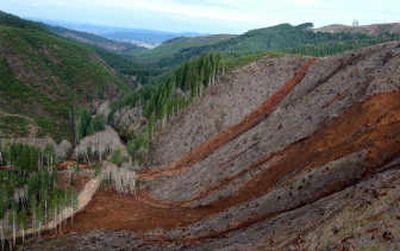Storm damage raises logging questions

SEATTLE – A photograph showing severe mudslides on a steep mountain slope in Lewis County that had been clear-cut near a Chehalis River tributary has spurred Weyerhaeuser Co. to examine whether it needs to change its logging practices.
The state approved the cut after a Weyerhaeuser geologist found “no potentially unstable areas” in a 106-acre tract near Stillman Creek, despite the presence of slopes of up to 50 degrees, which exceeded the threshold regulators used to define steepness.
The storm that ravaged southwest Washington earlier this month sent numerous slides crashing into Stillman Creek, a major tributary of the south fork of the Chehalis River. The slides added to the destructive mix of mud, wood debris and floodwaters that inundated homes and farms in the Boistfort Valley west of Chehalis.
A picture taken by a Seattle Times photographer during a helicopter flight over the area and first published last Sunday starkly illustrated the storm’s harsh effects on heavily logged lands.
It raised concerns at Weyerhaeuser, which has sought to cultivate an image of strong environmental stewardship. Corporate officials at the lumber and paper producer recently did their own flyover, scouting landslides there and elsewhere in the Northwest, where Weyerhaeuser owns more than 2 million acres.
“This storm was a catastrophic event, a natural disaster,” Weyerhaeuser spokesman Frank Mendizabal told the Times. He noted a Stillman Creek gauge recorded nearly 20 inches of rainfall in a 24-hour period.
“That said, what I can tell you is that we are going to look at this particular unit and others, and see what effects the storm had, and see if we need to make any changes in our practices.”
The state Department of Natural Resources, which regulates logging practices, will also investigate the damage.
“We’re going to look at how the storm tracked across the landscape,” said Eric Schroff, the department’s manager for southwest Washington. “It’s very much in our interest to see if there is anything that we can learn from this.”
Peter Goldman, founder of the Washington Forest Law Center, questioned why that slope was clear-cut in the first place.
“Weyerhaeuser has spent millions of dollars advertising how green they are,” Goldman said. “But the public has to have a debate. Is this the kind of industrial forestry we want?”
Even slopes that are thick with trees can slide as winter rains saturate the ground. Numerous studies have concluded that clear-cutting poses increased slide risks, and that building roads on those hillsides poses even higher risks.
A 2001 overhaul of the Washington Forest Practices Act strengthened rules about logging on steep, slide-prone tracts. When logging would likely trigger slides and put public resources or public safety at risk, the rules allow state officials to restrict the harvest.